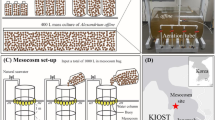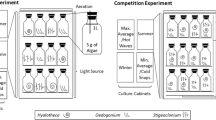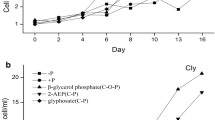Abstract
Batch and continuous cultures ofAnkistrodesmus braunii were established in an inorganic medium with growth rate limited by P. In batch culture, inoculation of lake water bacterial isolates ofPseudomonas sp. andFlavobacterium sp. showed that thePseudomonas isolate was capable of more rapid growth on algal exudates of lytic products than was theFlavobacterium isolate. When inoculated singly into a continuous culture (D=0.267 day−1; P level, 2ΜM), theFlavobacterium isolate initially caused a decrease in the population density of the alga, but then steady states for both organisms were obtained. ThePseudomonas isolate under the same conditions caused a rapid washout of the algal culture, and steady-state conditions were never obtained. When thePseudomonas isolate was added to the two-member, steady-state system ofA. braunii andFlavobacterium, the algal population again washed out of the vessel, followed by theFlavobacterium and then thePseudomonas isolate. A transient increase in the P concentration to 200ΜM in the culture vessel caused the low algal population level to increase, followed by increases in the bacterial isolates when the algal population was high enough to supply the required organic carbon source. The system demonstrated that competition for P between the alga and the bacteria can occur, and the results were dependent on the algal and bacterial relative growth rates. The bacterial growth rates were limited initially by organic substrates produced by the alga, and the different bacterial isolates competed for these substrates.
Similar content being viewed by others
References
Bell, W. H., and J. M. Lang: Selective stimulation of marine bacteria by algal extracellular products. Limnol. Oceanogr.19, 833–839 (1974)
Caperon, J.: Population growth responses ofIsochrysis galbana. Ecology49, 866–872 (1968)
Caperon, J., and J. Meyer: Nitrogen limited growth of marine phytoplankton. I. Changes in population characteristics with steady state growth rate. Deep Sea Res.19, 601–618 (1972)
Droop, M. R.: Vitamin B12 and marine ecology. IV. The kinetics of uptake, growth and inhibition ofMonochrysis lutheri. J. Mar. Biol. Assoc. U.K.48, 689–733 (1968)
Environment Canada: Analytical Methods Manual. Inland Waters Directorate, Water Quality Branch, Ottawa (1974)
Fogg, G. E.: The extracellular products of algae. Oceanogr. Mar. Biol. Annu. Rev.4, 195–212 (1966)
Foot, C. H., and C. B. Taylor: The influence of the composition of the medium on the growth of bacteria from water. Proc. Soc. Appl. Bacteriol.1, 11–13 (1942)
Hall, K. J.: Effect of nutrient enrichment on the heterotrophic uptake of organic solutes by microorganisms. Verh. Int. Verein. Theor. Agnew. Limnol.19, 280–285 (1975)
Hellebust, J. A.: Excretion of some organic compounds by marine phytoplankton. Limnol. Oceanogr.10, 192–206 (1965)
Hellebust, J. A.: Extracellular products. In W. D. P. Stewart (Ed.): Algal Physiology and Biochemistry. University of California Press, Berkeley, 838–863 (1974)
Hobbie, J. E., and R. T. Wright: Competition between planktonic bacteria and algae for organic solutes. Memorie 1st. Ital. Idrobiol., 18 (Suppl.), 175–185 (1965)
Rhee, G. Y.: Competition between an alga and an aquatic bacterium for phosphate. Limnol. Oceanogr.17, 505–514 (1972)
Rhee, G. Y.: A continuous culture study of phosphate uptake, growth rate and polyphosphate inScenedesmus sp. J. Phycol.9, 495–506 (1973)
Rhee, G. Y.: Phosphate uptake under nitrate limitation byScenedesmus sp. and its ecological significance. J. Phycol.10, 470–475 (1974)
Sharp, J. H.: Excretion of organic matter by marine phytoplankton: Do healthy cells do it? Limnol. Oceanogr.22, 381–399 (1977)
Shegg, E.: Beziehungen zwischen Planktomentwicklung und Bakterien in Vierwaldstattersee und Rotsee. Schweiz. 2. Hydrol.30, 289–296 (1968)
Smith, R. L., and V. E. Wiedeman: A new alkaline growth medium for algae. Can. J. Bot.42, 1582–1586 (1964)
Strickland, J. D., and T. R. Parsons: A practical handbook of sea water analysis. Fish. Res. Bd. Can. Bull.167 (1968)
Taylor, P. A., and J. LeB. Williams: Theoretical studies on the coexistence of competing species under continuous-flow-conditions. Can. J. Microbiol.21, 90–98 (1975)
Tolbert, N. E., and L. P. Zill: Excretion of glycollic acid by algae during photosynthesis. J. Biol. Chem.22, 895–896 (1956)
Whittingham, C. P., and G. C. Pritchard: The production of glycollate during photosynthesis inChlorella. Proc R. Soc. Lond. [Biol.]157, 366–372 (1963)
Wright, R. T., and J. E. Hobbie: Use of glucose and acetate by bacteria and algae in aquatic ecosystems. Ecology47, 447–464 (1966)
Author information
Authors and Affiliations
Rights and permissions
About this article
Cite this article
Mayfield, C.I., Inniss, W.E. Interactions between freshwater bacteria andAnkistrodesmus braunii in batch and continuous culture. Microb Ecol 4, 331–344 (1977). https://doi.org/10.1007/BF02013276
Issue Date:
DOI: https://doi.org/10.1007/BF02013276




